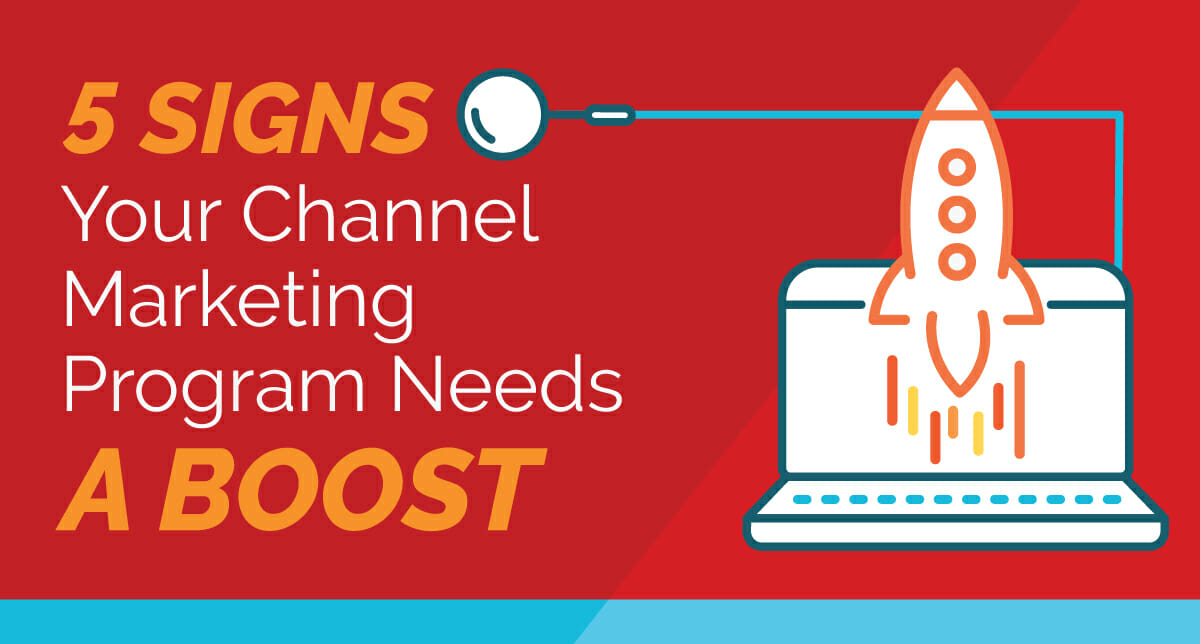5 Signs Your Channel Marketing Program Needs a Boost

Channel partners play a critical role in the sales ecosystem for many B2B companies. When done correctly, a channel program is an effective way for businesses to broaden their market and reach new segments, geographical areas, and target markets without the need to hire a large in-house sales team. Channel sales are a large book of business for many companies worldwide: According to Forrester, 70% of global revenue is generated through third-party channels.
But while channel partner marketing programs can be a strong fit for many B2B firms, planning, executing, and maintaining a successful channel program is often easier said than done. Channel programs can be complex—there are a lot of moving parts, some of which are controlled solely by the partner, and therefore are out of the vendor’s control.
The key to a successful channel partner program is effective marketing and enablement. The right marketing strategy and tactics help keep partners engaged, motivated, and empowered to make the sale. However, few companies who have a channel program in place do a truly great job of enabling their partners with next-level marketing support—often leading to a channel that doesn’t live up to its potential.
The Importance of Channel Marketing Support
Channel partner enablement is not a one-and-done activity. Getting a channel program off the ground isn’t akin to a rocket launch; instead it’s more like starting and stoking a fire that a vendor should never let fizzle out. The only way to keep those flames burning is to feed that fire with the right fuel, namely channel marketing and training resources. These can come in the way of training and messaging materials meant for internal partner consumption, ready-made sales collateral for prospects, co-marketing campaigns, and marketing development funds (MDF) to spur on partners to develop their own materials and campaigns.
All too often, B2B companies provide very little support on any of those fronts and then wonder why their channel isn’t driving more revenue. If you’ve got an inkling that your firm might fall into this category, consider for a moment whether your organization exhibits any of the following red flag symptoms. If so, it may be time to rethink your channel marketing practices.
- Your channel program is underperforming in key metrics: The most obvious red flag is when the metrics show that a firm isn’t getting enough into the channel. The metrics obviously vary by channel program and individual goals, but if volume of deals are suboptimal, deal size is an issue, or partners are not bringing in enough leads, that’s one of the most obvious red flags that something needs to change with channel marketing.
- There are no channel marketing experts in-house: Many vendor organizations fail to even provide the most basic materials that experienced partners would expect from a channel marketing program because the in-house marketing team lacks channel expertise and doesn’t know what it doesn’t know. Veteran marketers with little channel experience may shy away from channel marketing because it is out of their comfort zone. As a result, partners get the short shrift.
- The sales team is in charge of every aspect of channel relations: As a corollary to the previous point, another red flag is when the sales team is put in charge of every aspect of maintaining the channel program. Through no fault of their own, these salespeople may be missing quick wins and opportunities because they think like a salesperson instead of having a channel marketing strategy.
- Co-branded messaging is all over the place: If motivated partners aren’t getting the support they need, they may be going to prospects with ad hoc marketing materials of their own making. Without a comprehensive channel marketing strategy and processes in place, this could put branding investments at risk.
- No one has explicitly asked partners what kind of channel marketing support they need: Maybe your organization does have a channel marketing program in place, but your partners still struggle. It could be that the kind of support provided isn’t what your particular partners need. If no one has done a thorough assessment of partner needs, that’s a red flag for a channel marketing rethink.
Simply having a channel program is not enough—in some cases it can do more harm than good if a vendor doesn’t support the program with the right channel marketing resources.
If any of these red flags apply to your organization and you want to know how to get started rethinking your channel marketing program, contact us for an introductory chat.
For more channel partner marketing best practices, download our eBook: Must-Have Marketing Strategies for Partner Relationship Management.